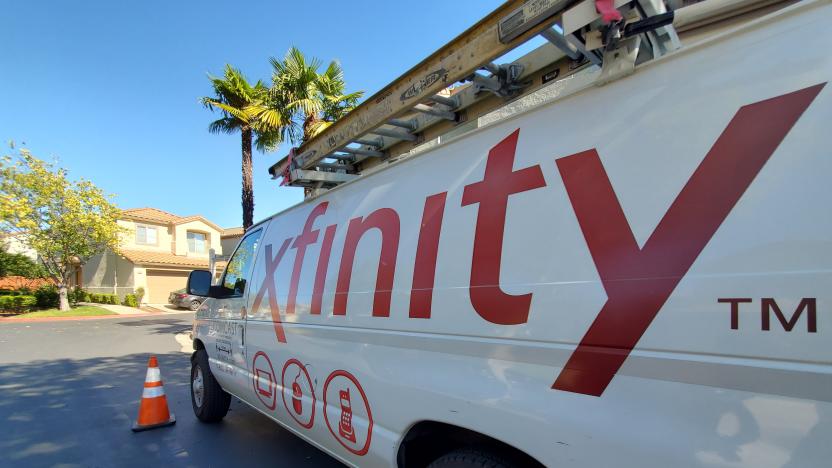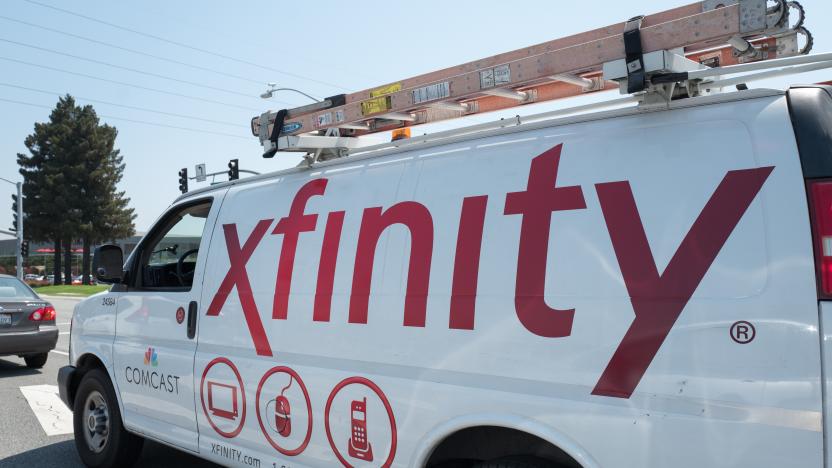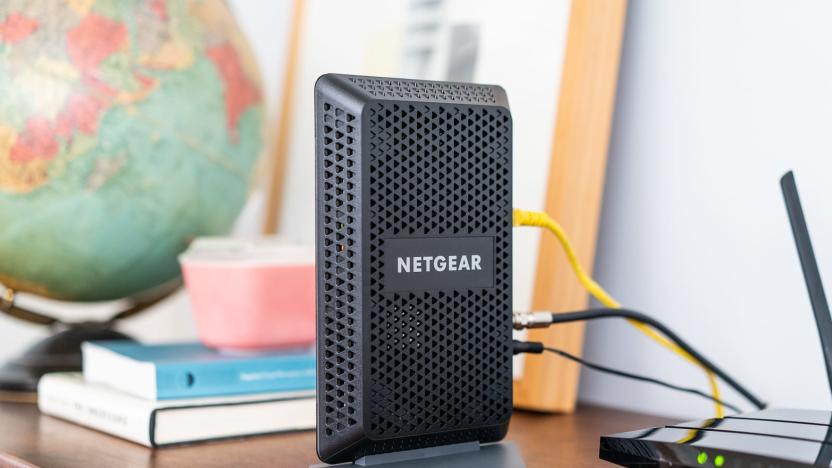cable modem
Latest

Comcast tests the first multigigabit cable modem
Comcast has tested the first cable modem that can offer multigigabit speeds, although it's not clear if you'll get to make full use of that performance.

Comcast takes another step toward '10G' with test of a multigigabit chip
If you can't get a fiber connection, DOCSIS 4.0 and '10G' could be your route to multigigabit speeds for uploads and downloads.

Law bars ISPs from charging rental fees for a modem you own
A law taking effect December 20th prevents your ISP from charging rental fees for modems and other boxes you own.

Comcast tests tech that enables gigabit upload speeds over cable
Just a few years ago Comcast started rolling out 1Gbps cable service and now it’s widely available in many areas across the country, but it still can’t match fiber for upload speed. Many fiber services offer gigabit speeds for customers on uploads and downloads, while the Xfinity package is limited to 35Mbps upload, at a time when people are creating more content and producing more video streams from home than ever before. This week however, Comcast ran a test that enabled 1.25Gbps speeds up and down on their live network at a home in Jacksonville.

The best cable modem
By Joel Santo Domingo and Thorin Klosowski This post was done in partnership with Wirecutter. When readers choose to buy Wirecutter's independently chosen editorial picks, Wirecutter and Engadget may earn affiliate commission. Read the full guide to cable modems. After researching nearly 100 cable modems over the past five years, we recommend the Netgear CM600 if you have cable Internet and you want to stop paying your Internet service provider a separate modem rental fee. You can recoup the cost of the modem in as little as nine months—and then start saving up to $10 each month. The CM600 is reliable, supports the fastest Internet speeds available to the vast majority of Americans, and it's compatible with just about every non-gigabit plan from every cable Internet service provider in the US—including Comcast Xfinity, Spectrum (formerly Time Warner, Charter, and Bright House), Cox, Suddenlink, Cable One, and WOW—which gives you the flexibility to switch providers if you move or switch ISPs. The CM600 works well for plans up to 600 megabits per second, because it's a DOCSIS 3.0 modem that can handle 24 downstream channels and eight upstream channels. The biggest downside is that, while the CM600 has positive reviews from owners, it comes with only a one-year warranty, while most modems come with a two-year warranty. The Motorola MB7621 is a 24×8 DOCSIS 3.0 modem that supports the same performance levels as the Netgear CM600. The MB7621 is less expensive and comes with a two-year warranty, a year longer than the CM600's coverage. But it doesn't appear on quite as many ISP approved modem lists as the Netgear modems; Cable One, Cox, and Comcast Xfinity all have the MB7621 on their online approved lists, but you'll have to call Spectrum and WOW to make sure it will work on their networks and what speeds it will support. The MB7621 doesn't have quite as large a pool of reviews, but what people have to say is very positive. It's a great choice if your ISP supports it. America's average Internet speeds measure well below 100 Mbps, ranging from the low 20s to figures approaching 70 Mbps, depending on which survey you pick. If your plan is in that range and you don't intend to upgrade beyond 300 Mbps anytime soon, we recommend the Netgear CM500. The CM500 matches the ISP compatibility of the pricier CM600, but its maximum download and upload speeds are lower (300 Mbps on the CM500 versus 600 Mbps on the CM600, though Suddenlink certifies it for 500 Mbps speeds). The CM500 has a good reputation for reliability, but like the CM600 it comes with only a one-year warranty. (We recommend 16×4 modems like the CM500 even if your plan would work with a slower modem, because ISPs are dropping support for 8×4 modems. You'd save barely any money up front and have to replace your modem years earlier, so we don't recommend it.) If you already have a gigabit Internet plan and your ISP allows you to use your own modem, the Motorola MB8600 is the best of the three DOCSIS 3.1 modems that are widely available right now because of its relatively low price and its two-year warranty. Though it's overkill for almost everyone, you'll need a DOCSIS 3.1 modem to guarantee gigabit speeds from most cable ISPs, and the MB8600 is also compatible with gigabit Internet on networks that still use the DOCSIS 3.0 standard, for example Cable One supports both DOCSIS 3.0 (32x8) and DOCSIS 3.1 modems for its GigaOne service. Don't get a gigabit modem unless you already have gigabit service or know it's available. The added expense of the DOCSIS 3.1 modems isn't worth it until you're on one of these new (and pricey) plans—especially since your ISP may roll out gigabit over fiber rather than cable. And they may not even let you bring your own modem once they do roll out gigabit service.

Netgear melds 802.11ac WiFi with cable modem, gives us a cable gateway we'd actually like
If you're reading this, you're likely the sort who looks down on the hybrid cable modem and WiFi gateway your cable company foists upon you: it's like setting your wireless network in stone. Netgear is hoping to make that all-in-one experience a little more pleasurable by merging the best of two very fast worlds. It's planning to show a cable gateway (not pictured yet) that unites a DOCSIS 3.0 cable modem, no slouch in itself, with even speedier 802.11ac WiFi to share the connection in the home. The router side has all the familiar extras, such as DLNA media sharing, guest networks and shared USB storage, but it's clear the real perk is simply making sure the hundreds of megabits per second in bandwidth from that cable pipe carry through to your future laptops and tablets. Netgear hasn't said how close it might be to shipping the cable gateway, but it'll be showing the practical device at the ANGA Cable trade show this week -- along with a 1.2Gbps download, 320Mbps upload cable modem that could give even Google Fiber a run for its money.

Charter Cable boosts downloads to 100Mbps, keeps uploads limited to a modest 5Mbps
Good news Charter customers, you're getting a speed bump! The DOCSIS 3.0-based cable service is boosting both download and upload speeds across all tiers of its service -- starting at the bottom with its Express package, which will be a 15 Mbps down and 3 Mbps up offering from now on. The "flagship" Plus level is getting its rates almost doubled from 18 Mbps down and 2 Mbps up to 30 Mbps down and 4 Mbps up, offering you plenty of bandwidth for streaming, torrenting and browsing all at the same time. The fastest connection is getting not just a new speed (100 Mbps down), but a new name -- Ultra 100. Sadly, your $60 a month for the big bits doesn't get you particularly blazing upload speeds. Charter's tops out at a pretty modest 5 Mbps up. Check out the PR after the break for a few more details.

Virgin Media testing 1.5Gbps internet for lucky Londonites
Jealous of Comcast customers with their 105Mbps cable hook ups or those lucky residents of the Kansas cities relishing in Google's 1Gbps service? Well add Londonites to the list of people that drive you to indulging in one of the seven deadly sins. Virgin Media has finally started testing its DOCSIS2-powered 1.5Gbps network in the heart of merry ol' England. Right now it's being enjoyed by a group of test sites around Old Street that also get a 150Mbps upload connection. Virgin claims it's the fastest broadband in the world, which may be true if you're not counting lab experiments. The really good news is that it's based on the same tech already delivering 100Mbps to residents across the country so, if the trial goes well, it should be trivial to deliver these mind numbing speeds to the rest of its customers. PR after the break.

Rogers listens, bumps data caps, lets you stream a few extra Netflix movies a month
Rogers hasn't exactly made a lot of fans with the rather draconian caps on its cable modem service. But the company wants you to know, it has heard your complaints and doesn't want to cut you off from your precious, bandwidth-intensive Netflix streams. That's why it's raising the limits on its three top tier plans later this month. Extreme subscribers are getting a bump from 80GB to 100GB, Extreme Plus users from 125GB to 150GB, and Ultimate customers from 175GB to 250GB. The company is even boosting speeds, you know, to help you make more efficient use of that newly raised data ceiling -- from 15Mbps to 24Mbps for the Extreme and 25Mbps to 32Mbps for Extreme Plus. It's always nice to see a company listen to its customers, and come on, data caps aren't all that bad.

Comcast Cable Show 2011 demo features 1Gbps cable modem speeds, new Xfinity TV UI
As promised, Comcast CEO Brian Roberts treated Cable Show 2011 attendees to a quick demo of the company's latest and greatest tech earlier today. The presentation consisted of the new Xfinity TV platform with all its cloud processing and internet content from Facebook and others, as well as a speed test running on a Comcast cable modem that broke through the 1Gbps speed barrier on the production network. There's no word on when home users might see such speeds but the company promised to "keep up the pace as the internet continues to evolve" -- let's hope that extends to the increasingly restrictive 250GB bandwidth cap. The demo of new DVR software also went off without a hitch, appearing to run smoothly and showing off a vision of "cloud processing" that speeds up search, personalization and recommendations in the program guide by handling them at the head end instead of on the box itself. We're still waiting to get our hands on the RF remote and see if the experience is just as smooth ourselves, but for now you can get a taste in the 17 minute video embedded above.

Intel acquires TI's cable modem unit, might be sneaking into your AV rack
Intel's been trying to break into the home entertainment market for years, and while it's made some inroads, it's also looking at a notable list of ho hum attempts that never managed to gain traction. Take the CE3100 processor, for instance -- a couple of years ago, the outfit seemed certain that this here chip would be powering every last living room box for the rest of eternity, and nowadays it's hardly a household name. But this week, Intel has picked up Texas Instruments' cable modem unit, which gives it a direct link into the very area it's been trying to exploit. The goal of the acquisition -- which is scheduled to close in the fourth quarter of this year -- is to combine TI's Puma product lines with DOCSIS and Intel SoCs. Once that magical marriage takes place, Chipzilla intends to push out complex set-top boxes, residential gateways and modem products, possibly even going for the OEM artery. Details beyond that are few and far betwixt, but we doubt it'll be too long before the pickup begins to bear fruit.

Virgin Media testing DOCSIS 3.0 to new limits with 200Mbps, 3D and 1080p
Forget 101Mbps Internet service or even the 160Mbps available in on J:COM in Japan, Virgin Media is about to put a lucky few of its slick new modems to real work, testing 200Mbps internet, "full HD" broadband content (we take that to mean 1080p) and 3D. All delivered via DOCSIS 3.0, the downside is that at least for the next six months this pilot project will be extended only to about 100 "lead adopters" around Ashford, Kent for testing. We've heard all we need to get packed for a move, how about you?[Via Hexus]

Virgin Media launches 50Mbps internet service in UK
Remember that fanciful cable modem that Virgin Media unveiled last month? Now it's clear as day what it will be used for. This week, the operator has announced the launch of its lightning fast 50Mbps high-speed internet service in the UK. The service has instantly placed VM at the top of the class in terms of speed, though it certainly won't come cheap. Reportedly, it'll run locals some £51 ($77) per month, though the monthly fee is lowered to £35 ($53) if users also take a Virgin phone line for £11 ($17) / month. There's no mention of what regions will have access right away, though it should be rolled out "country-wide" over the next six months. Not to be completely outdone, rival BT has also come forward with plans to trial a 40Mbps service during the summer of 2009. Who knows -- maybe our "status quo" 2Mbps connections will eventually be akin to 56k modems of yesteryear.[Thanks, Alex]

Virgin Media shows off stylish 50Mbps cable modem
This truly may be a world's first: a cable modem you don't feel incredibly pressured to relegate to the rear of your networking stash. Yes friends, that succulent device you see above is Virgin Media's shockingly stunning 50Mbps cable modem, which unsurprisingly relies on DOCSIS 3.0 technology in order to provide such 1337 speeds. It's still not as speedy as Ambit Broadband's channel bonding modem, nor can it hold a candle to whatever Sigbritt Löthberg had going on in Sweden, but 50Mbps isn't anything to sneeze at. No word on pricing just yet (don't worry, you'll pay it), but it should be available for UK-based speed freaks before the year's end.[Via TrustedReviews]

Cablevision and Charter gear up for DOCSIS 3.0 rollouts
Comcast nabbed the first US DOCSIS 3.0 deployment award by pushing the technology out to select Minnesota residents in April, but both Charter and Cablevision are making sure to not fall too far behind. During its most recent quarter earnings call, Cablevision COO Tom Rutledge noted that DOCSIS 3.0 would be "operational this year," with around 20% of its footprint going live in 2008 and 100% to be covered by mid-2010. Charter is also poised to introduce the lightning fast broadband capabilities to its loyal customers, with CEO Neil Smit affirming that it would be launched in at least some markets "later in the year." We'd like to think this means we can all look forward to 100Mbit/sec cable internet in the not-too-distant future, but who knows how long it'll take those other MSO's to join the bandwagon.[VIA DSLReports]Read - Cablevision DOCSIS 3.0 rolloutRead - Charter DOCSIS 3.0 rollout

Time Warner Cable looks to bring internet content to TVs
Shortly after hearing TiVo's top dog speak of a "whole home model" to reduce the amount of STBs required for entertaining individuals in various rooms, along comes Time Warner Cable's chief executive talking up some innovation of its own. We'll be frank -- we're not entirely sure what Glenn Britt is getting at here, but through a broken series of quotes, we're led to believe that the carrier is prepping some "equipment" that will easily bring internet content to TVs. Not like there isn't a perfect solution for this quandary already, but we digress. Specifically, he mentions a " new wireless cable modem that will allow you to network everything in your house," which is about as broad / vague as you can get. Nevertheless, it's enough to keep us watchin', though we can't say our expectations are extraordinarily high. [Disclosure: Engadget is part of the Time Warner family][Via eHomeUpgrade]

Comcast shows off blisteringly fast channel bonding modem
Two little words that could potentially give new life to copper, at least in the high-speed internet department, have found their way into the news once again, and this time it's Comcast who's showing us just what channel bonding can do. While you may have been scratching your head about Ambit Broadband's ridiculous claims, it looks like the technology may actually be edging closer to hitting the mainstream. Apparently, Comcast's CEO was able to demonstrate such a modem in front of the public and cable competitors alike, and while he claimed that it could reach speeds of 150Mbps, it was the testing that got everyone all riled up. Based on DOCSIS 3.0, the modem was able to download a 300MB file "in a few seconds," and he even snagged the 32-volume Encyclopedia Britannica 2007 and Merriam-Webster's visual dictionary in "under four minutes." Interestingly, it was noted that the FiOS competitor "could be available within a couple years," but if fiber crawls to our house before this stuff is ready to rock, it'll sure to be hard to hold off.

Ambit Broadband's Channel Bonding cable modem does 144Mbps / 30Mbps
Questions surrounding cable's ability to keep up with the big boys have been circulating for what feels like ages, but an intriguing new product from the labs of Ambit Broadband has some fairly substantial numbers to go along with it. The firm's Channel Bonding cable model will be available exclusively to subscribers of Hanaro, and by partnering with Netwave, the device will enable "triple play service" consisting of VoIP, IPTV, and high-speed internet. More interesting, however, is the reported maximum speeds that this thing can handle, as it boasts the "capability to bond three downstream channels to enable a maximum 144Mbps downstream and up to 30Mbps upstream." The modem also supports the usual interfaces such as gigabit Ethernet and USB 2.0, but it supposedly comes pre-ready for DOCSIS 3.0 and IPv6 -- you know, the protocols used to shatter the Internet2 transmission record. While it may all sound a bit sensational at the moment, the truth shall be unveiled when Ambit / Netwave delivers 150,000 of said modems to Hanaro "during Q2" of this year.

TUAW Guide: Wireless Broadband on your Mac
Ah, the open road. What's more American than being mobile, drifting along the highways and byways, traveling hither and yon, free as a debt-laden bird? While I try to rein in that derailed train of road metaphor, let's consider the options for Mac users and wireless data. Many of you would love to take your Internet access with you as you travel on family vacation or spring break; for others, terrestrial broadband (cable modem or DSL) is unavailable or prohibitively expensive at your fixed location. Good news for all: the choices on the wireless access front are better than ever before. We'll cover the US domestic options today, and hopefully get to Europe/UK and other international options sometime soon. More on Mac wireless broadband after the break.

Comcast rolls out Motorola SBV5220 cable modem with battery backup
If you've made the break and use a VoIP service as your only landline, you may have noticed one of the main downsides of the option (especially if you live in a rural or isolated area): if the power goes out, so does your phone line. Hooking up a UPS can help, but can also be expensive and may not provide power for more than an hour or so. However, help is on the way, at least if you get your VoIP access as part of a bundled plan from Comcast. The company plans to offer Motorola's SBV5220 cable modem to at least some of its customers as part of its $39.95 Digital Voice service. The SBV5220 includes its own lithium-ion backup battery, which provides up to 8 hours of power. Of course, if you use a cordless phone and it isn't fully charged before the lights go off, this may not do you a whole lot of good, so be sure to keep those phones charged.




